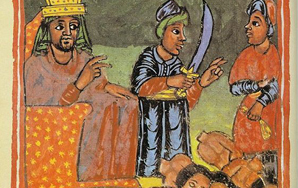
10 Horrifying Methods Of Capital Punishment From Around The World
1. Slow slicing (China)
a form of torture and execution used in China from roughly AD 900 until it was banned in 1905. In this form of execution, the condemned person was killed by using a knife to methodically remove portions of the body over an extended period of time.
This was civilized torture and execution, though. Recipients of the slow slicing were sometimes given opium as an act of mercy, or to prevent them from fainting. Turns out getting your body lopped off bit by bit with a knife can overwhelm a person.
2. Suffocation in ash (Ancient Persia)
an execution method where a tower/room was filled with ash, into which the condemned person was plunged. Wheels were constantly turned while he was alive, making the ash whirl about, and the person died by gradual suffocation as he inhaled the ash.
This is a pretty creative way to murder a person.
3. Decapitation (Japan)
In Japan, decapitation was a common punishment, sometimes for minor offences. Samurai were often allowed to decapitate soldiers who had fled from battle, as it was considered cowardly. Decapitation was historically performed as the second step in seppuku (ritual suicide by disembowelment). After the victim had sliced his own abdomen open, another warrior would strike his head off from behind with a katana to hasten death and to reduce the suffering. The blow was expected to be precise enough to leave intact a small strip of skin at the front of the neck—to spare invited and honored guests the indelicacy of witnessing a severed head rolling about, or towards them; such an event would have been considered inelegant and in bad taste.
…Oh, and then there’s this unsettling anecdote:
One of the most brutal decapitations was that of Sugitani Zenjubō (ja:杉谷善住坊), who attempted to assassinate Oda Nobunaga, a prominent daimyo in 1570. After being caught, Zenjubō was buried alive in the ground with only his head out, and the head was slowly sawn off with a bamboo saw by passers-by for several days.
4. Blowing from a gun (Great Britain)
a method of execution in which the victim is typically tied to the mouth of a cannon and the cannon is fired.
The British weren’t the only ones to do this — the Mughal emperors, the Ottoman Turks, and folks in Algiers and Sumatra also got in on the action. In Afghanistan, or as I like to call it, “almost Iraq,” this practice continued until 1930.
5. Stoning
Stoning people to death continues to occur in many countries around the world, whether officially sanctioned or not. The following are two excerpts from the Iran penal code for stoning adulterers:
Article 102 – An adulterous man shall be buried in a ditch up to near his waist and an adulterous woman up to near her chest and then stoned to death.
Article 104 – The size of the stone used in stoning shall not be too large to kill the convict by one or two throws and at the same time shall not be too small to be called a stone.
Some nice clear rules to guide your barbarism!
6. Dismemberment
There have been many methods of removing limbs from prisoners as a form of capital punishment, but what follows is a Persian method from the 19th century called shekkeh, described by Robert Binning:
the criminal is hung up by the heels, head downwards, from a ladder or between two posts, and the executioner hacks away with a sword, until the body is bisected lengthways, terminating at the head. The two several halves are then suspended on a camel, and paraded through the streets, for the edification of all beholders. When the shekkeh is to be inflicted in a merciful manner, the culprit’s head is struck off, previous to bisecting the trunk
7. Crushing
This form of execution, no longer sanctioned by any governing body, has occurred via various methods throughout history. It was used as a method of forcing a plea bargain in court by placing increasingly heavier stones on a person’s chest — in French, peine forte et dure (“hard and forceful punishment”). It was also commonly carried out via elephants in South and South-east Asia for over 4,000 years. The only recorded American instance of the stone method occurred during the Salem witch trials:
Giles Corey […] was pressed to death on September 19, 1692, during the Salem witch trials, after he refused to enter a plea in the judicial proceeding. According to legend, his last words as he was being crushed were “More weight”, and he was thought to be dead as the weight was applied.
8. Sawing
There are various methods, check it out:
Different methods of death by sawing have been recorded. In cases related to the Roman Emperor Caligula, the sawing is said to be through the middle. In the cases of Morocco, it is stated that that the sawing was lengthwise, both from the groin and upwards, and from the skull and downwards. In only one case, in the story about Simon the Zealot, the person is explicitly described as being hung upside-down and sawn apart vertically through the middle, starting at the groin, with no mention of fastening or support boards around the person, in the manner depicted in illustrations. In other cases where details about the method, beyond the mere sawing act, are explicitly supplied, the condemned person was apparently fastened to either one or two boards prior to sawing.
9. Scaphism, or “the boats” (Ancient Persia)
The intended victim was stripped naked and then firmly fastened within the interior space of two narrow rowing boats (or hollowed-out tree trunks) joined together one on top of the other with the head, hands and feet protruding. The condemned was forced to ingest milk and honey to the point of developing a severe bowel movement and diarrhoea, and more honey would be rubbed on his exposed appendages to attract insects. He would then be left to float on a stagnant pond or be exposed to the sun. The defenceless individual’s faeces accumulated within the container, attracting more insects which would eat and breed within his exposed flesh, which — pursuant to interruption of the blood supply by burrowing insects — became increasingly gangrenous. The feeding would be repeated each day in some cases to prolong the torture, so that fatal dehydration or starvation did not occur. Death, when it eventually occurred, was probably due to a combination of dehydration, starvation and septic shock. Delirium would typically set in after a few days.
I have to say, this doesn’t sound fun.
10. Gas chamber
There have been many recorded instances, but the most well-known of course was in Nazi Germany.
Gas chambers were used in the Third Reich as part of the “public euthanasia program” aimed at eliminating physically and mentally retarded people and political undesirables in the 1930s and 1940s. In June 1942 many hundreds of prisoners of Neuengamme concentration camp, amongst which 45 Dutch communists, were gassed in Bernburg. At that time, the preferred gas was carbon monoxide, often provided by the exhaust gas of gasoline-powered cars, trucks or army tanks.
During the Holocaust, gas chambers were designed to accept large groups as part of the Nazi policy of genocide against the Jews. Nazis also targeted the Romani people, homosexuals, physically and mentally disabled, intellectuals and the clergy.
Gas chambers in vans, concentration camps, and extermination camps were used to kill several million people between 1941 and 1945. Some stationary gas chambers could kill 2,000 people at once.











